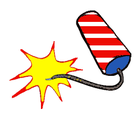Shanghai Street View: Firecracker Fuss

After a bit of deliberation, I decided to focus this week’s column on the recent debate over firecrackers in Shanghai rather than the feistier and fast-moving brouhaha over taxi apps that has also been making headlines. The taxi topic is perhaps a bit sexier and quite colorful, centered on capitalistic cabbies who refuse to pick up regular passengers as they pursue more lucrative customers who book through taxi apps.
But the firecracker issue seems more substantive, speaking to the concept of cultural traditions, their value in society, and how and whether they should adapt with changing social conditions. As the New Year’s season officially ends, I’m also running out of time to raise this interesting topic, which has already largely disappeared from the headlines as people look forward to spring and the warmer weather ahead.
The explosive issue made one final fizzle in the headlines last week with reports that the series of firecracker recycling centers set up around the city have once again met with dismal results. One newspaper report said that of the 16 recycling centers around the city, 15 didn’t receive a single firecracker in the latest holiday season. That was an improvement from the previous year, when none of the recycling centers received any unused firecrackers in their first year of operation.
City residents cited a number of reasons for their lack of interest in the program. Some said there were too few centers, making it inconvenient for them to recycle their unused firecrackers. Others said no compensation was offered, giving them little incentive to make the special trip to a recycling center.
Maybe I’m being cynical, but I suspect that these centers were set up to show the city was trying to reduce pollution, even though they were never given the resources or scale they needed to succeed. After all, the city already knew after last year’s dismal performance that residents weren’t using the centers, and yet it did very little to change the program in its second year to try and improve the outcome.
More broadly speaking, the city’s half-hearted effort seems to reflect the mixed emotions that many Chinese feel towards changing their age-old tradition of setting off firecrackers during the Lunar New Year. On the one hand, many people realize that such explosives are not only dangerous, but also contribute heavily to the city’s air pollution. But at the same time, many people seem reluctant to abandon a tradition that has centuries of history and is so closely linked to one China’s of biggest achievements, the invention of gunpowder.
Here’s where I have to step in as an outsider and comment that perhaps it’s time for the people of Shanghai and China to rethink the idea of what is meant by traditions, and whether they can and should be modified to adapt to changes over time. Apart from an outright ban, the most obvious way to reduce the individual use of firecrackers would be for Shanghai to stage its own major fireworks show for everyone to enjoy. The city has a beautiful natural venue for such a show over the Huangpu River in the city center, which would allow people to watch from both the Bund and the newer Lujiazui Financial District.
And yet the city hosts no such show, even though it stages fireworks displays during other festivals like western New Year and the October 1 National Day holiday. I asked one of my local friends why there isn’t any such show, and he said the Lunar New Year is a time when people like to set off firecrackers individually to personally welcome in the New Year in accordance with tradition.
While such traditions are certainly important, I would argue there’s no harm in modifying them to adapt to changing conditions in major cities like Shanghai. In the west most people now use electric lights to decorate their Christmas trees, even though for centuries they tradition adorned such trees with burning candles. But such candles also posed a fire hazard, not to mention the mess they created with dripping wax. People now often use fake plastic Christmas trees as well, which are also more environmentally friendly and don’t shed bothersome needles all over on the floor.
Hong Kong already bans the individual use of firecrackers during the Lunar New Year, and instead stages a major fireworks show each year over Victoria Harbor that can be enjoyed by everyone with minimal pollution and risk of injury. Perhaps some in Hong Kong privately grumble about such a ban, but in my man years living there in the past I never once heard anyone complain about the restriction.
At the end of the day, Chinese New Year is all about family reunions, providing a time for people to take a break from their busy lives to rekindle old relationships and be thankful for what they have in the present. That spirit will always lie at the heart of the Lunar New Year and is the tradition most worth preserving. The use of firecrackers may also be important, but there’s certainly little harm in modifying that part of the tradition to be safer, cleaner and just a little quieter.
